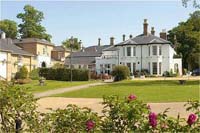Stowmarket Suffolk England: Stowmarket is a town of 15,059 inhabitants and is located in the county of Suffolk. This town is on the A14 between Bury St Edmunds and Ipswich and on the railway between London and Norwich. It is the largest town in Mid Suffolk, on the banks of the River Gipping which is joined by the River Rat further south. The town takes its name from “Stow” an Anglo-Saxon word meaning “main square”. Stowmarket received a charter to hold a market in 1347 from Edward III of England, which added the “market” suffix to the town’s name. Even today, a bi-weekly market is held on Thursdays and Saturdays. The county of Suffolk has an area of almost 1,500 square miles and a population of 730,000.
August 21, 2015
July 2, 2010
Bedford Lodge Hotel Newmarket
If you are visiting the famous horse racing town of Newmarket, Suffolk, in the near future, you might want to consider staying at the luxurious Four Star Bedford Lodge Hotel, one of the finest establishments in the area. Offering luxurious suites, well appointed guest rooms and a calm peaceful atmosphere, the Bedford Lodge Newmarket will not disappoint as your choice of hotel in the town. It is also ideal for wedding events, offering a fantastic setting among 3 acres of rose gardens, which you can also walk around and enjoy when the weather is fine. Other facilities include Jacuzzi, sauna, steam rooms, indoor pool, health club and first class restaurant. Newmarket is the headquarters of UK horse racing and also the main centre for horse breeding, it is a historic market town, located in a beautiful part of the country. Rooms are available in the Bedford Lodge Newmarket from 120 pounds per night, book, relax and enjoy! Newmarket is located between Bury St Edmunds and Cambridge and is only 28 miles from Stanstead Airport.
August 27, 2009
Bury St Edmunds Sudbury and Mildenhall Suffolk
One of East Anglia’s most historic towns, Bury St Edmunds in Suffolk was considered a royal town by the Saxons and would certainly have been known by the Romans long before this. A monastery was built in Bury St Edmunds in around 633 by order of the King of the East Angles (Sigebert) and it was here that King Edmund was buried in 903 AD. The town grew around the abbey which later became the meeting place of the Barons of England as they formulated the Magna Carta. Much later during the 17th century the infamous Bury St Edmunds witch trials were held there. There are still remains of the abbey close to the town centre, though it was mostly destroyed during the 16th century. To the south of Bury St Edmunds, sitting beside the River Stour, Sudbury is another historic Saxon town, recorded in the Saxon Chronicles of 799 AD. Sudbury later grew prosperous through the wool and silk trade, it was also a well known haunt of famous artists such as John Constable who painted scenes of the area. A village which also benefited from the wool trade is Long Melford (located to the north of Sudbury), the proportions of its Holy Trinity Church attest to this, built with ‘wool’ money, it appears more like a cathedral. Two stately homes in the village of Long Melford, also built with ‘wool’ money, are Melford Hall and Kentwell Hall. To the north-west of Bury St Edmunds is the small market town of Mildenhall, which has held a regular market since the 15th century, Mildenhall made big news in the nineteen forties when a large haul of Roman silver was found there, it is probably best known as the home of the air base RAF Mildenhall. Suffolk Map.
